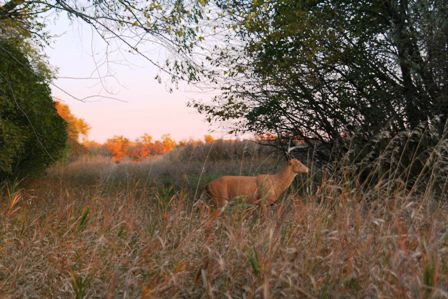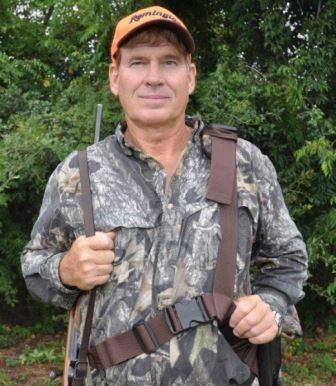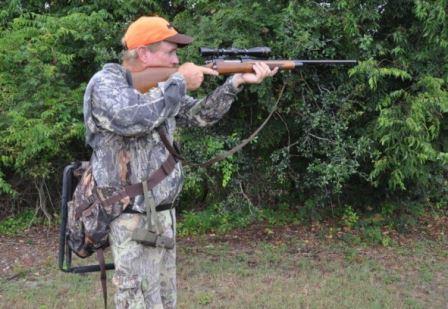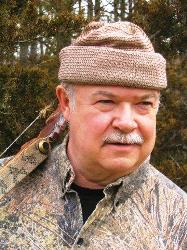By Bernie Barringer
A public land hunter tells you how to find
the spots most hunters overlook.

I shot this old buck in 2010 on public land in Iowa. I moved several times until I landed on the exact right location where a river swept up close to a steep hill.
All serious whitetail hunters live for that magical time of the year; those three weeks in November when the most amazing things can happen at any moment. Bucks are on their feet at all hours of the day or night. Core areas and home ranges become meaningless as the mature males of the species pant and sweat and grind out the hours, searching for receptive females in a frantic effort to procreate during this short period of frenzied rutting activity.
You wait for this window of opportunity all year. Don’t spend it in the wrong spot.
Some spots are obvious and hunters gravitate to these well-known locations. But some spots aren’t so easy to see. Consider hunting one of these three great stand sites that most hunters overlook.
1. River Bends
In Iowa a couple of years ago, I killed a 6-year-old buck on public land on the 12th day of what was intended to be a seven-day hunt. On the fifth day of the hunt I found sign from a lot of deer activity on the outside of a large, sweeping river bend. Once in a stand, I began to see deer movement including one nice shooter buck. However, most of the movement was out of range, so I had to adjust a couple times. Twice over the next few days I moved my stand about 100 yards before I settled on the exact spot where I killed him. The outside bend of a river swept up against a steep bluff, which funneled the deer movement into a narrow corridor where I scored.
Deer, like all animals take the path of least resistance when travelling. They are looking for places that it is easy to walk and that’s where the trails develop. This was a perfect place to intercept a cruising buck because it very naturally channeled the deer movement into a narrow area, an area I could easily cover with a treestand in the right spot.
2. Jumpers
I lucked onto the type of location I call “jumpers.” I happened to see a buck come out of the tip of a draw 100 yards away when I was sitting in a treestand in a bushy fencerow. I rattled at him, but after a short look, he crossed the top of the hill and entered the point of a draw on the other side. After that morning’s hunt, I walked over there and was surprised to see a series of rubs and a small trail with several sets of big tracks in it. I realized that it was a perfect place for a buck to jump from one drainage to another with minimal exposure. This ideal shortcut left him exposed for only a few seconds.

Google Earth screen captures show good examples of the overlooked stand site. This one is obviously a field corner.
Frankly, not many people hunt these places I came to identify as “jumpers,” but they can be absolutely dynamite if you find one in the right spot. These drainages are referred to as hollows, ditches, draws or ravines—depending on the local jargon—where an arm of one ravine reaches out into a field near where an arm of an adjacent ravine comes out. These are crossing points for deer moving from one to the other, and bucks check them when cruising for receptive does.
Looking at an aerial photo will give you plenty of these to check out, but you must get a personal up-close look to find the good ones. Most will have little to no sign, but when you find the one the bucks really like to use, you will know it. Rubs, tracks and often a scrape or two will be the tip-off that you are in the right spot.

Field corners often have a tractor trail through them, which give you more visibility. Field corners are also great locations to place a decoy where bucks can see them from a distance.
3. Field Corners
In keeping with the theme that bucks do not like to expose themselves in the open any more than is absolutely necessary, field corners are another overlooked stand site. These are basic and simple locations, easy to identify on an aerial photo or a topographical map. Heck, you can even see them from the road many times.
We are talking about the square corner of an open field that has woods on at least two sides of it. Because they do not like to expose themselves, bucks will stay just inside the woods as they travel around the corner. This creates a pinch point that concentrates the travel, upping your odds of being within range of a buck by funneling their activity into a small area.

My friend Chris Dunkin shot this tremendous buck as it exited the arm of a ravine. Finding the perfect set in a “jumper” put him within range of a buck of a lifetime.
Interestingly, these places can have lots of sign or little to no sign and it doesn’t seem to make much difference during the rut. For some reason, I have seen these areas all torn up with rubs and scrapes or, on the other end of the spectrum, maybe just a very faint trail. The amount of sign in these areas seems to have no relation to the amount of travel they get when the bucks get on their feet and begin cruising. Some of these are really good and don’t have the sign to prove it.
Conclusion
Because I hunt mostly public lands which receive a lot of pressure from other hunters, I have found that the most obvious funnels, pinch points and areas with rutting sign get so much attention that the bucks soon learn to avoid them. If you learn to look for those less obvious points that concentrate the travel of cruising bucks, you can take advantage of not only the rut movement, but the tendencies of bucks to avoid the other hunters. This will help you put yourself in a much better position to bag a big one.
To read more great articles by Bernie Barringer, click here.
About Bernie Barringer
 Bernie Barringer hunts a variety of species in several states and Canadian provinces. He has published more than 400 articles in two dozen outdoor magazines and authored ten books on hunting, fishing and trapping. The latest is Bear Baiter’s Manual. He is the managing editor of Bear Hunting Magazine, and blogs his hunts on his website www.bowhuntingroad.com.[hs_action id=”7476″]
Bernie Barringer hunts a variety of species in several states and Canadian provinces. He has published more than 400 articles in two dozen outdoor magazines and authored ten books on hunting, fishing and trapping. The latest is Bear Baiter’s Manual. He is the managing editor of Bear Hunting Magazine, and blogs his hunts on his website www.bowhuntingroad.com.[hs_action id=”7476″]
3,331 total views, 1 views today













 Gene Wensel is a widely known and universally respected hunter who is dedicated to traditional archery equipment. He specializes in whitetail deer but he’ll shoot anything, from Iowa to Africa. He has written for just about every bowhunting and whitetail periodical. Gene, his brother Barry, and their buddy Mike Mitten, are known as “Brothers of the Bow.” Their website is
Gene Wensel is a widely known and universally respected hunter who is dedicated to traditional archery equipment. He specializes in whitetail deer but he’ll shoot anything, from Iowa to Africa. He has written for just about every bowhunting and whitetail periodical. Gene, his brother Barry, and their buddy Mike Mitten, are known as “Brothers of the Bow.” Their website is 








 Outdoor writer and speaker Steve Sorensen is the author of
Outdoor writer and speaker Steve Sorensen is the author of 